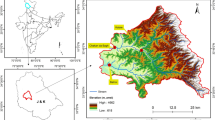Abstract
This study assesses spatio-temporal changes in the content of macrocomponents and organic substances in waters of the drained part of the Great Vasyugan Mire in taiga zone of Western Siberia. Studies have shown that the drained area of the Great Vasyugan Mire is characterized by increased concentrations of all components in the chemical composition of its waters compared to the pristine area, with significant differences in the content of Са2+, Mg2+, Fetotal, \({\text{NH}}_{4}^{ + }\), Cl–, K+, Na+, Cl–, CO2, and DOC in the waters observed only between individual sampling sites. Cluster analysis confirmed the differences in the chemical composition of waters of the drained and pristine areas of the Great Vasyugan Mire by dividing them into two clusters, with the exception of samples taken in lagg. Due to the overgrowth of ditches, the mire is currently in the process of self-restoration, which results in minimal differences between the chemical compositions of waters of the drained and pristine areas of the Great Vasyugan Mire. It is noted that the chemical composition of waters can vary significantly across the mire area, depending largely on the site’s location relative to water paths and drainage ditches. Factor analysis reveals that the conditions of the formation of the chemical composition of waters also vary across the territory, depending on hydrology and thermal regime of the mire, which are transformed due to drainage and the pyrogenic factor; this results in increased mire water levels contributing to increases in concentrations of Са2+, Mg2+, Feto-tal, \({\text{NH}}_{4}^{ + }\), K+, Na+, \({\text{HCO}}_{3}^{ - }\), and \({\text{NO}}_{3}^{ - }\) in the waters and their transport out of the mire, which significantly impacts the quality of river waters.



Similar content being viewed by others
REFERENCES
Trenberth, K., Changes in precipitation with climate change, Climate Res., 2011, vol. 47, no. 1, pp. 123–138. https://doi.org/10.3354/cr00953
WMO Statement on the state of the Global Climate “State of the Global Climate 2021” (WMO-No. 1290), 2022.
Kirpotin, S.N., Berezin, A., Bazanov, V., Polishchuk, Y., Vorobiov, S., Mironycheva-Tokoreva, N., Kosykh, N., Volkova, I., Dupre, B., Pokrovsky, O., Kouraev, A., Zakharova, E., Shirokova, L., Mognard, N., Biancamaria, S., Viers, J., and Kolmakova, M., Western Siberia wetlands as indicator and regulator of climate change on the global scale, Int. J. Envir. Stud., 2009, vol. 66, no. 4, pp. 409–421. https://doi.org/10.1080/00207233.2014.945695
Savichev, O.G., Mazurov, A.K., Pipko, I.I., Sergienko, V.I., and Semiletova, I.P., Spatial patterns of the evolution of the chemical composition and discharge of river water in the Ob River basin, Dokl. Earth Sci., 2016, vol. 466, no. 1, pp. 59–63. https://doi.org/10.1134/S1028334X16010141
Ise, T. and Dunn, A., High sensitivity of peat decomposition to climate change through water-table feedback, Nat. Geosci., 2008, no. 1, pp. 763–766. https://doi.org/10.1038/ngeo331
Feurdean, A., Galka, M., Florescu, G., Diaconu, A.-C., Tanţău, I., Kirpotin, S., and Hutchinson, S.M., 2000 years of variability in hydroclimate and carbon accumulation in western siberia and the relationship with large-scale atmospheric circulation: A multi-proxy peat record, Quat. Sci. Rev., 2019, p. 105948. https://doi.org/10.1016/j.quascirev.2019.105948
Sinyutkina, A.A., Drainage consequences and self-restoration of drained raised bogs in the south-eastern part of Western Siberia: Peat accumulation and vegetation dynamics, Catena, 2021, no. 205, p. 105464. https://doi.org/10.1016/j.catena.2021.105464
Sinyutkina, A.A., Maloletko, A.A., Mironycheva-Tokareva, N.P., Russkikh, I.V., Serebrennikova, O.V., Strel’nikova, E.B., Vishnyakova, E.K., and Kharanzhevskaya, Yu.A., Post-fire ecological consequences within the drained site of the Great Vasyugan Mire: Retrospective water-thermal regime and pyrogenic disturbance estimation, IOP Conf. Ser.: Earth Envir. Sci., 2020, vol. 408, p. 012037. https://doi.org/10.1088/1755-1315/408/1/012037
STP 0493925-008-93: Determination of Carbon of Water-Soluble Compounds by the Method of Tyurin in the Modification of SibNIIT, Tomsk, 1993.
Maloletko, A.A., Sinyutkina, A.A., Gashkova, L.P., Kharanzhevskaya, Yu.A., Magur, M.G., Voistinova, E.S., Ivanova, E.S., Chudinovskaya, L.A., and Khaustova, A.A., Effects of long-term drainage on vegetation, surface topography, hydrology and water chemistry of north-eastern part of Great Vasyugan Mire (Western Siberia), IOP Conf. Ser.: Earth Envir. Sci., 2018, vol. 211, no. 1, p. 012033, https://doi.org/10.1088/1755-1315/211/1/012033
Muller, F.L.L. and Tankere-Muller, S.P.C., Seasonal variations in surface water chemistry at disturbed and pristine peatland sites in the Flow Country of northern Scotland, Sci. of the Total Envir., 2012, no. 435–436, pp. 351–362.
Haapalehto, T., Kotiaho, J.S., Matilainen, R., and Tahvanainen, T., The effects of long-term drainage and subsequent restoration on water table level and pore water chemistry in boreal peatlands, J. Hydrol., 2014, vol. 519, pp. 1493–1505.https://doi.org/10.1016/j.jhydrol.2014.09.013
Kharanzhevskaya, Yu.A. and Sinyutkina, A.A., Effects of wildfire on the water chemistry of the northeastern part of the Great Vasyugan Mire (Western Siberia), IOP Conf. Ser.: Earth Envir. Sci., 2021, vol. 928, p. 012006. https://doi.org/10.1088/1755-1315/928/1/012006
Harris, L.I., Limited effect of drainage on peat properties, porewater chemistry, and peat decomposition proxies in a boreal peatland, Biogeochemistry, 2020, vol. 151, pp. 43–62. https://doi.org/10.1007/s10533-020-00707-1
Kalyuzhnyi, I.L., General features of the formation of the hydrochemical regime of the main types of swamps in Russia, Meteorol. Gidrol., 2018, no. 8, pp. 72–81.
Funding
This study was supported by the Russian Foundation for Basic Research, project no. 22-27-00242.
Author information
Authors and Affiliations
Corresponding author
Additional information
Translated by A. Ovchinnikova
Rights and permissions
About this article
Cite this article
Kharanzhevskaya, Y.A. Effect of Drainage on Spatio-Temporal Variation in Water Chemistry of the Great Vasyugan Mire. Geogr. Nat. Resour. 43 (Suppl 1), S36–S43 (2022). https://doi.org/10.1134/S1875372822050110
Received:
Revised:
Accepted:
Published:
Issue Date:
DOI: https://doi.org/10.1134/S1875372822050110




